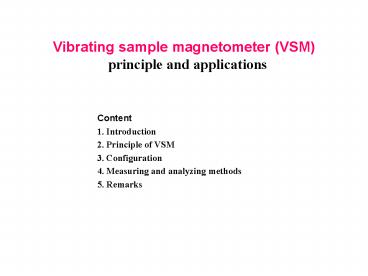Vibrating sample magnetometer VSM principle and applications - PowerPoint PPT Presentation
1 / 19
Title:
Vibrating sample magnetometer VSM principle and applications
Description:
Among numbers of magnetic measurement equipment, Vibrating sample magneto-meter ... Ms(T): determines magnetic phases, Curie points, ratio of different phases. ... – PowerPoint PPT presentation
Number of Views:11825
Avg rating:4.8/5.0
Title: Vibrating sample magnetometer VSM principle and applications
1
Vibrating sample magnetometer (VSM) principle
and applications
Content 1. Introduction 2. Principle of VSM 3.
Configuration 4. Measuring and analyzing
methods 5. Remarks
2
1. Introduction
- Magnetic measurement is a powerful method to
characterize properties of materials. - Among numbers of magnetic measurement equipment,
Vibrating sample magneto-meter (VSM) is known as
a very effective way to determine magnetization. - VSM offers different measuring modes. By
analyzing the results, many useful information of
materials can be extracted.
3
(No Transcript)
4
VSM sample is vibrating with a standardized
frequency ( ) during the measurement. H
does not depend on t but M depends on t AC
measurements always improve signal to noise
ratio. By this method, the signal is directly
proportional to magnetization.
5
(No Transcript)
6
(No Transcript)
7
3. Configuration
- VSM DMS model 800
- Maximum magnetic field 1.4 Tesla.
- Field step 1Oe
- Sensitivity 1x10-5 emu (mAm2)
- Vector coil configuration enables magnetic moment
can be determined in the direction parallel and
perpendicular to the field (Mx My) - Angular controller -80o - 440o, step 0.5o
- Temperature controller 77K-700K
- Measuring process is controlled by an accompanied
software. Different measurements can be set in a
sequence. - Samples
- Bulks
- Powders
- Thin films
8
(No Transcript)
9
(No Transcript)
10
4. Measuring and analyzing methods
VSM is used to measure the magnetic properties of
materials as a function of magnetic
field, temprature,and time
- 4.1. Hysteresis loop measurement Different
modes - Full loop Half loop 5-10 Segments
- Major loop
- Saturation magnetization Ms
- Coercivity Hc, Remanence Mr Squareness S
- Switching field distribution SFD
- (BH)max
- Minor loop
- Virgin curve measurement
11
(No Transcript)
12
(No Transcript)
13
(No Transcript)
14
- 4.2 Remanence measurements
- Isothermal remanence magnetization (IRM)
measures remanence, start from demagnetized state - DC demagnetization (DCD) measures remanence,
start from demagnetized state - ?M curve By comparing IRM and DCD curves,
magnetic interaction of materials can be
predicted (based on Stoner-Wohlfarth mode).
15
(No Transcript)
16
4.3 Angular dependent measurement Hysteresis
loops as well as remanence curves can be measured
at different angles From the angular dependence
of some parameters (Hc, Mr), magnetization
switching mechanism can be determined coherent
or incoherent rotation etc. 4.4 Time dependence
measurement Magnetization relaxation can be
studied by this method. 4.5 Torque
measurement Torque signal can be obtained from
magnetization perpendicular to the field
direction L(?) ?0MyH
17
Angular dependence of Hc
Thermo-magnetization curve
18
- 4.6 Thermo-magnetic measurement
- Ms(T) determines magnetic phases, Curie points,
ratio of different phases. - Mr(T) determines compensation point
- Other transition points can be detected Spin
reorientation temperature - Field cooled (FC) and zero field cooled (ZFC)
determine blocking temperature in fine particles
system.
19
5. Remarks
- As VSM is a very sensitive magnetometer, careful
corrections are needed to obtain faithful
results - In thin films, which have low magnetic moment,
the diamagnetic effect must be subtracted from
the whole signal. - In some cases, demagnetization field has to be
taken into account, especially in case of thin
film with magnetization out of the film plane. - Magnetic history of materials have to be
considered to analyze results AC demagnetized,
DC demagnetized. - Disadvantages
- Not very high field
- Temperature dependence measurements take long
time.































